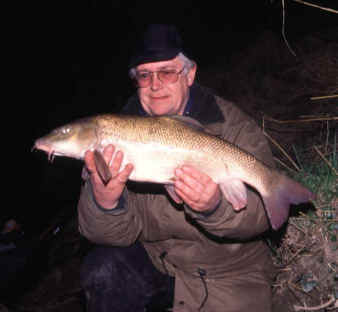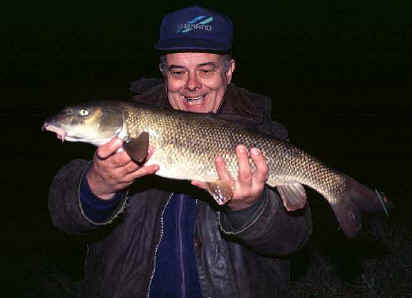Winter Barbel
By Graham Marsden
I’m often asked when is my favourite time for catching barbel, and I have no hesitation in answering that it has to be the last two or three weeks of the season. I’ve probably caught more barbel in that period than at any other time. But I enjoy barbel fishing all through the winter period. Obviously, conditions are, as always, the governing factor, and a set of poor conditions over these last few weeks of the season will have the same degenerating affect on the fishing as ever. Given reasonable conditions, however, this run-down to the river season can be a most magical time for catching barbel.

The most difficult choice I have to make is whether to visit a stretch where the fish are above average size for the river and sit it out for a something a bit special, or fish a more prolific stretch and enjoy lots of bites and good sport for most of the day. Fortunately, my lifestyle right now allows me to fish two or three times a week and I can, if the fancy takes me, fairly regularly follow both options. Although what tends to happen is that I become engrossed in one pursuit or the other and usually end up throwing all my eggs in one basket. Or should that be “throwing all my bait in one swim?"
Most of my barbel fishing takes place on two rivers, the upper Severn and the river Dane. Upper Severn barbel, in several hot-spots, can creep into double figures, and well over in just the odd very localised area. The choice on the upper Severn is to either fish the more prolific swims for perhaps half a dozen barbel in the 5lb to 7lb bracket in a day. Or to fish the much less prolific areas where the chances are that you will blank, but any rewards could possibly be in the shape of an 8lb plus barbel, and even a double if you are very lucky. Such barbel may not compare with the run of big doubles that the Great Ouse produces like clockwork, but believe me, for the upper Severn, such fish are still quite hard to come by. The good news is that it seems to be getting better as each year goes by.
The river Dane is a small river compared to the Severn, but one that is growing in stature as far as the barbel fishing is concerned. Not so much in the size of barbel it holds, although it has produced the very odd double, but in the number of barbel it is possible to catch from the well known barbel stretches. These fish may average a lowly 5lb or so (compared to the Severn) but on a good day you can have some absolutely marvellous sport in this small river where the barbel have huge fighting hearts.
The trouble with the upper Severn in winter – and the Dane to a lesser extent – is that it is so prone to fluctuating water levels. Obviously, I know that this can be a problem on other rivers throughout the country, but when the water rises on chalk streams the “damage" is confined to just that – extra water. On spate rivers like the Severn and the Dane any rise in water level brings with it a pronounced change in water colour, and it is that that puts the fish off feeding until they have either settled to this change in conditions, or the river fines down a little. Unfortunately, settled conditions in our winters of recent years seem to be as rare as rocking horse droppings.
So what it comes down to is that you have to plan your fishing on the Dane or Severn in winter by not having a plan at all. It is a simple opportunist scheme, whereby you go fishing (given that there are no other factors – like work(!) – to prevent this) whenever the river is in good enough condition to offer you a realistic chance of catching fish. Of, course, you don’t wait for ideal conditions or you would never fish at all some winters, with last winter being a good example. What you do is watch for the trend to be right. If the trend of the river level is falling, or even up and has been fairly steady for a day or two, and the water temperature is rising, or steady, then that is the time to go.
To make this type of opportunist fishing much easier you need to be prepared to go at almost a moment’s notice, for reasonable conditions have to be taken advantage of while they last, which is usually not very long. So it makes sense to have bait at hand, ready prepared, where the only effort you have to make is to lift the freezer lid and transfer what you need to your seatbox or rucksack, usually the night before you intend to fish so that it has plenty of time to thaw out.
What I do is prepare about 10 pints of hemp in a pressure cooker. Nothing special here, simply soaking the hemp overnight in cold water and boiling it for about 30 minutes in the pressure cooker. I add a tablespoon of bicarbonate of soda to darken the seeds (which I don’t think makes a scrap of difference to what the barbel think of it). The hemp is then allowed to soak in the juices until it cools and then thoroughly washed off in a sieve under a high pressure cold water tap. It is then split into separate one pint portions in sealed plastic bags, left at room temperature for another 24 hours to allow it to mature a little and bring out the flavour, and then stored in the freezer. When I fish a swim where there are few but bigger barbel I can take one or two pints of hemp, or several pints if I choose to fish a more prolific swim. Any unused hemp can be re-frozen two or three times without any ill-effects. Although I would exercise more caution about this in summer when higher temperatures can accelerate the deterioration process.

Luncheon meat is pre-prepared too. I cut the meat into cubes and triangles of various sizes, spray it with whatever flavour I fancy, or coat it with a powdered flavour, place in a plastic bag, and then in the freezer. Freezing, and then thawing prior to fishing is an excellent way of drawing the flavour deep into the meat. This ensures that there will always be some flavour emanating from the meat even when it has been in the water for an hour or more. This is particularly important in winter when cold water prevents a great deal of flavour from being released. Whatever flavour you choose to try, make sure you use it in both the groundbait (crushed crumb, hempseed, other particle, or whatever) as well as the hookbait.
Luncheon meat can also be made into a paste and flavoured much more effectively than when in semi-solid cubes. I make mine by squashing it up with a potato masher and then adding a few drops, or a few sprays, of whatever flavour I fancy. Daft as it may seem, but I’ve done quite well with strawberry flavour. Perhaps fish are like kids in that they too like weird flavour mixtures of sweet and savoury. Another thing about paste is that the flavour, natural or otherwise, can escape much more readily in cold water.
I like to have lobworms on hand too, for these can be a tremendous bait when the water is coloured, providing the temperature is not too low. I collect these through the summer months in the usual way, ie, at night from low cut, damp grass. I store them in a lidded, plastic dustbin that has a fairly good depth of soil in it. The best soil is two layers of largely unbroken, grassed turf, each layer a spade deep. Keep the bin in a shaded area and don’t allow the soil to dry out, although I have never had a problem that way. Also, throw in the occasional helping of kitchen scraps, such as potato peelings, used tea leaves (break open the tea bags!) lettuce and other green leaves, etc.
You can keep lobworms for months in such conditions, providing you change the turf every month or so, or every time the worms have wriggled their way though it often enough to change it into a fine texture. All you have to do when you change the soil is tip the bin over, load the new turf into it, then pick the lobs out of the old stuff and lob them into the new. In no time at all they will have dug their way into their new home. Use the old soil to fill the hole from where you dug the new.
Another good bait on some days are boilies, and these offer no problems for opportunist fishing, for all you need are a selection of shelf-life boilies to hand for whenever you need them. There are some swims on the Severn and Dane where boilies are the best bait of all, and others where they just cannot compete against luncheon meat. You would think that the “boilie swims" are those where the bait has been used on a regular basis and the barbel are well and truly switched onto them. But not so, for there doesn’t seem to be any pattern to this, and as far as I can make out there is no reason why they are so acceptable in one area, but not in another. I can only imagine that in the best boilie areas someone, unknown to me, is baiting heavily with boilies within a mile or two of where I’m fishing. Yes, barbel travel two or three miles at times, and there is probably evidence that they travel even further when there is reason to do so. It follows then that they will take their habits with them, wherever they have learned them.
My rods are always tackled up and ready to go. Apart from the fact that I can’t be bothered to tackle up and strip down my rods every time I go fishing, it is a great help to opportunist fishing if all you have to do is pick one or two ready tackled up rods from your tackle store and stuff them in your holdall. A holdall that already has rod-rests, bank-sticks, brolly and landing net in it.
The rods I use are from my own Interceptor range manufactured by Harrisons. They are fitted with fixed-spool reels loaded with 7lb line to a 6lb hook length if I’m targeting the smaller shoal fish to 6lb or so, or 10lb main line with 9lb Herculine Micro hook length for bigger fish. Terminal tackle is a simple leger bead link, stopped with a swivel and buffered by a rubber bead. It is a simple matter to change leger weight sizes, or to change from bomb to swimfeeder as the swim demands or the fancy takes me. Hook length is usually a foot to 18ins long but very often I will use a yard or more if I think the barbel will respond to such a long hook length, or the swim is better suited to one. I prefer the longer hook length when fishing a swim with a particularly slow current, for in such swims the barbel have more time to “test" the bait before accepting it. A long hook length generally presents a bait that behaves more naturally.

Go steady with the loose feed. Where you can almost certainly get away with overloading the swim in summer, you can’t in winter, and little and not so often should be the order of the day. One pint of hemp and half a dozen samples of hookbait thrown into the swim as soon as you arrive is enough to kick-start any barbel swim in winter, and may very well be all you will need for the whole session. My inclination is to introduce a little less than a pint, and then top up as and when there is any activity in the swim. This may come in all shapes and sizes, and may not necessarily be barbel activity. Any kind of action, however, could be an indication that the hemp, and any other feed you have introduced, is being consumed, and therefore needs to be topped up. If you have any doubt, leave it out. Use a bait dropper to introduce the feed in swims where you can use one.
More often than not the barbel will bite with the same vigour with which they bite in warmer weather, giving big rod-benders that simply cannot be mistaken for leaves fouling the line, or any other activity that is anything but barbel. Anything else and it is usually too late to do anything about it anyhow. The main difference between summer and winter barbel fishing is that usually the barbel bite more consistently in summer, but winter barbel are fitter and fatter. And don’t neglect floodwater, some really big barbel can be caught when the water is high and coloured.
Many thanks to Graham Marsden for allowing Barbel Fishing World the use of the above article.

